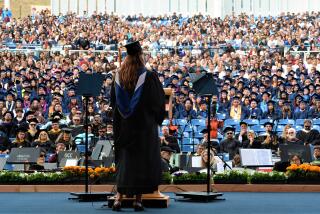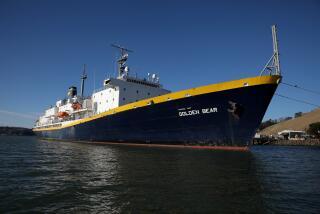OCC’s Marine Program Hoists More Sail
- Share via
Most boaters dream of sailing the Virgin Islands, a yachting paradise. But recently two Virgin Island sailors came to Orange County--and stayed for a year--just to go sailing.
What drew them was Orange Coast College’s marine program, one of the most comprehensive collections of nautical courses, lectures and seminars in the United States.
Each year 3,000 students sign up for one of OCC’s marine studies programs, which range from beginning sailing in Lido 14s to ocean passages on the 65-foot, college-owned Alaska Eagle.
The program, which began as a smattering of classes offered in the mid-’70s, now consists of hundreds of courses, including an unusual offering called “Ocean Passages” that takes advanced sailing students on a 2,225-mile sail to Hawaii.
Early classes were under the direction of Dave Grant, who served as dean of students from 1975 to 1985 and administered the marine program part time. But by 1985 the program had grown so large and become so popular that Grant was appointed full-time marine programs director. By 1983, he had been joined by Brad Avery, a part-time sailing instructor who became full-time director of the OCC sailing program.
This month the marine program will expand even more as the college completes construction of a 3,000-square-foot second-floor addition to the waterfront sailing base in Newport Beach. The new $400,000 facility will allow the college to offer a wider variety of marine-related courses and seminars, according to Avery.
Before construction of the addition, “some classes were held on campus and some were held here at the sailing base.” Avery says. “But the base has no real classroom (just a cavernous rowing center) and no heating. We had great boat docks, a fleet of boats, good storage, and we had this tremendous waterfront site, but no classrooms.”
In addition, campus classrooms were becoming increasingly hard to come by, Avery says. “We’d try to reserve classrooms for particular nights and there wouldn’t be any available.”
So, 4 years ago the college began a fund-raising campaign to expand the base. “What is exciting about this,” Grant says, “is that it was all done by private funds. This is the only community college in Orange County” to finance new classrooms with private money.
The impetuous for the campaign was a $150,000 matching grant from the Harry and Grace Steele Foundation. The addition is being christened the Steele Sailing Loft in recognition of the donation.
“Before the Steele Foundation grant we were running on a dream,” Avery says. “We’re not a yacht club. We don’t have a lot of money. Most of our donations came from students who gave us $25, $50 or $100. This expansion gives our destiny back to us. It centralizes the entire program. And from the standpoint of instructors, we can attract better instructors because we have a better facility.”
Among the new courses being offered this spring are “Introduction to Naval Architecture,” “Marine Electronics” and “How to Buy a Boat.” Some of the other classes that were previously held on campus will now be at the center. They include “Celestial Navigation” and “Coastal Navigation.”
“Other new programs we’ve added include seminars,” Avery says. “We can now offer seminars for 100 people.”
The first seminar will be held Saturday and Sunday, Feb. 18 and 19, and will feature popular lecturers John Neal and Barbara Marrett, a cruising couple from Friday Harbor, Wash., who have spent 10 years sailing more than 100,000 miles to such places as Pitcairn Island, the Galapagos, Easter Island, the Tuamotus, the Marquesas, Tahiti and Samoa.
In March a seminar on cruising the Channel Islands will be offered by Mike Pyzel, an expert on the nearby islands. Pyzel is a veteran of more than 400 Channel Island cruises and is a former Coast Guard search and rescue officer.
In addition to the classroom programs, the college will continue to offer its beginning, intermediate and advanced sailing classes. More than 50 such courses are planned for this spring and are taught in the college fleet which includes five 30-foot Shields and 12 Lido 14s.
The college’s big boat fleet includes Marda, a 50-foot powerboat, Saudade, a 47-foot sailboat and Alaska Eagle, a 65-foot sailboat that has become the program’s best-known vessel.
Last September, Alaska Eagle completed its fourth Pacific cruise, which took it 8,000 miles from Orange County to Hawaii, Alaska, Canada and back in 104 days. Along the way a total of 54 students sailed aboard Alaska Eagle during the six legs of the cruise. Nine students and two instructors were on board during each leg.
After departing Newport Beach on June 11, the boat sailed to Hawaii on the first leg. Students on the second leg cruised around all the Hawaiian Islands. Students on the third leg boarded in Oahu and sailed almost 3,000 miles to Glacier Bay, Alaska. Students on the fourth and fifth legs cruised through Alaska and Canada. Students on the sixth leg brought Alaska Eagle home from Vancouver, Canada.
Many of the students on the cruise started out in the OCC sailing program in Lido 14s and worked their way up, Avery says. “They’d start in the Lidos and say, ‘What do I have to do to sail on Alaska Eagle?’ ”
The Alaska Eagle program is the college’s most unusual course, Avery says, and is designed to give sailors additional offshore skills in navigation, piloting, sail handling, steering, provisioning, maintenance and safety. For most students, it is their first major cruise, he says.
The boat is Coast Guard-licensed with a route to Hawaii and Alaska. However, this year’s “Ocean Passages” course will go only to Hawaii. “It is hard to do the Alaska portion,” Avery says, “so we’re not offering it this year, but we will probably do it again in the future.”
Alaska Eagle will depart Newport Beach for Hawaii on June 10. Students interested in the program are advised to apply now. Anyone 16 or older who is physically fit with at least intermediate-level sailing experience is encouraged to apply, Avery says. Applicants are selected on the basis of sailing ability, physical ability, skills and “willingness to participate fully in all aspects of shipboard life.”
For students who can’t participate in the Hawaii cruise, the college will also offer day and overnight courses covering offshore sail training during cruises to Santa Catalina and the Channel Islands.
Other “big boat” classes are offered in Saudade and include local offshore sailing. “Introduction to Big Boats” covers the basics of handling yachts 30 to 50 feet in length. Reefing, sail changing and gear handling are covered in the class. “Ocean Sailing,” also taught aboard Saudade, covers sail selection and sailing techniques for light and heavy weather.
For information on any of the Orange Coast College marine courses, including the Alaska Eagle cruises, call (714) 432-5005. Or write Orange Coast College Community Services, P.O. Box 5005, Costa Mesa, Calif. 92628.
More to Read
Sign up for The Wild
We’ll help you find the best places to hike, bike and run, as well as the perfect silent spots for meditation and yoga.
You may occasionally receive promotional content from the Los Angeles Times.






